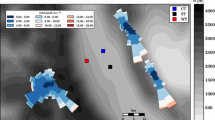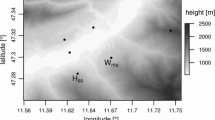Abstract
In recent studies of atmospheric turbulent surface exchange in complex terrain, questions arise concerning velocity-sensor tilt corrections and the governing flow equations for coordinate systems aligned with steep slopes. The standard planar-fit method, a popular tilt-correction technique, must be modified when applied to complex mountainous terrain. The ramifications of these adaptations have not previously been fully explored. Here, we carefully evaluate the impacts of the selection of sector size (the range of flow angles admitted for analysis) and planar-fit averaging time. We offer a methodology for determining an optimized sector-wise planar fit (SPF), and evaluate the sensitivity of momentum fluxes to varying these SPF input parameters. Additionally, we clarify discrepancies in the governing flow equations for slope-aligned coordinate systems that arise in the buoyancy terms due to the gravitational vector no longer acting along a coordinate axis. New adaptions to the momentum equations and turbulence kinetic energy budget equation allow for the proper treatment of the buoyancy terms for purely upslope or downslope flows, and for slope flows having a cross-slope component. Field data show that new terms in the slope-aligned forms of the governing flow equations can be significant and should not be omitted. Since the optimized SPF and the proper alignment of buoyancy terms in the governing flow equations both affect turbulent fluxes, these results hold implications for similarity theory or budget analyses for which accurate flux estimates are important.










Similar content being viewed by others
References
Arritt RW, Pielke RA (1986) Interactions of nocturnal slope flows with ambient winds. Boundary-Layer Meteorol 37(1):183–195
Babić K, Bencetić Klaić Z, Večenaj Ž (2012) Determining a turbulence averaging time scale by Fourier analysis for the nocturnal boundary layer. Geofizika 29(1):35–51
Baldocchi DD, Finnigan JJ, Wilson K, Paw UKT, Falge E (2000) On measuring net ecosystem carbon exchange over tall vegetation on complex terrain. Boundary-Layer Meteorol 96(1–2):257–291
Carper MA, Porté-Agel F (2004) The role of coherent structures in subfilter-scale dissipation of turbulence measured in the atmospheric surface layer. J Turbul 5:32–32
Cheng Y, Parlange MB, Brutsaert W (2005) Pathology of Monin–Obukhov similarity in the stable boundary layer. J Geophys Res 110(D6):D06101
Christen A, Van Gorsel E, Vogt R, Andretta M, Rotach MW (2001) Ultrasonic anemometer instrumentation at steep slopes-wind tunnel study-field intercomparison-measurements. MAP Meeting Schliersee (MAP Newsletter) 15:206–209
Dutton JA, Fichtl GH (1969) Approximate equations of motion for gases and liquids. J Atmos Sci 26(2):241–254
Feigenwinter C, Bernhofer C, Eichelmann U, Heinesch B, Hertel M, Janous D, Kolle O, Lagergren F, Lindroth A, Minerbi S, Moderow U, Mölder M, Montagnani L, Queck R, Rebmann C, Vestin P, Yernaux M, Zeri M, Ziegler W, Aubinet M (2008) Comparison of horizontal and vertical advective CO\(_2\) fluxes at three forest sites. Agric For Meteorol 148(1):12–24
Fernando HJS, Pardyjak ER (2013) Field studies delve into the intricacies of mountain weather. Eos Trans AGU 94(36):313–315
Fernando HJS, Pardyjak ER, Di Sabatino S, Chow FK, De Wekker SFJ, Hoch SW, Hacker J, Pace JC, Pratt T, Pu Z, Steenburgh JW, Whiteman CD, Wang Y, Zajic D, Balsley B, Dimitrova R, Emmitt GD, Higgins CW, Hunt JCR, Knievel JG, Lawrence D, Liu Y, Nadeau DF, Kit E, Blomquist BW, Conry P, Coppersmith RS, Creegan E, Felton M, Grachev A, Gunawardena N, Hang C, Hocut CM, Huynh G, Jeglum ME, Jensen D, Kulandaivelu V, Lehner M, Leo LS, Liberzon D, Massey JD, McEnerney K, Pal S, Price T, Sghiatti M, Silver Z, Thompson M, Zhang H, Zsedrovits T (2015) The MATERHORN—unraveling the intricacies of mountain weather. Bull Am Meteorol Soc. doi:10.1175/BAMS-D-13-00131.1
Foken T (2008) Micrometeorology. Springer, Berlin, pp 106–108 (306 pp)
Geissbühler P, Siegwolf R, Eugster W (2000) Eddy covariance measurements on mountain slopes: the advantage of surface-normal sensor orientation over a vertical set-up. Boundary-Layer Meteorol 96(3):371–392
Haiden T, Whiteman CD (2005) Katabatic flow mechanisms on a low-angle slope. J Appl Meteorol 44(1):113–126
Higgins CW, Meneveau C, Parlange MB (2007) The effect of filter dimension on the subgrid-scale stress, heat flux, and tensor alignments in the atmospheric surface layer. J Atmos Ocean Technol 24(3):360–375
Higgins CW, Meneveau C, Parlange MB (2009) Geometric alignments of the subgrid-scale force in the atmospheric boundary layer. Boundary-Layer Meteorol 132(1):1–9
Horst TW, Doran JC (1988) The turbulence structure of nocturnal slope flow. J Atmos Sci 45(4):605–616
Hutchins N, Marusic I (2007) Evidence of very long meandering features in the logarithmic region of turbulent boundary layers. J Fluid Mech 579:1–28
Jensen DD, Nadeau DF, Hoch SW, Pardyjak ER (2015) Observations of near-surface heat flux and temperature profiles through the early evening transition over contrasting surfaces. Boundary-Layer Meteorol. doi:10.1007/s10546-015-0067-z
Kaimal JC, Finnigan JJ (1994) Atmospheric boundary layer flows: their structure and measurement. Oxford University Press, New York, 289 pp
Kaimal JC, Haugen DA (1969) Some errors in the measurement of Reynolds stress. J Appl Meteorol 8(3):460–462
Klewicki JC, Metzger MM, Kelner E, Thurlow EM (1995) Viscous sublayer flow visualizations at R\(_\theta \cong \) 1 500 000. Phys Fluids 7(4):857–863
Kunkel GJ, Marusic I (2006) Study of the near-wall-turbulent region of the high-Reynolds-number boundary layer using an atmospheric flow. J Fluid Mech 548:375–402
Lee X (1998) On micrometeorological observations of surface-air exchange over tall vegetation. Agric For Meteorol 91(1):39–49
Lee X, Massman WJ, Law BE (2004) Handbook of micrometeorology: a guide for surface flux measurement and analysis. Kluwer Academic Publishers, Dordrecht, pp 33–35 (208 pp)
Li M, Babel W, Tanaka K, Foken T (2013) Note on the application of planar-fit rotation for non-omnidirectional sonic anemometers. Atmos Meas Tech 6:221–229
Łobocki L (2014) Surface-layer flux-gradient relationships over inclined terrain derived from a local equilibrium, turbulence closure model. Boundary-Layer Meteorol 150(3):469–483
Lorke A, McGinnis DF, Maeck A (2013) Eddy-correlation measurements of benthic fluxes under complex flow conditions: effects of coordinate transformations and averaging time scales. Limnol Oceanogr Method 11:425–437
Mahrt L (1982) Momentum balance of gravity flows. J Atmos Sci 39:2701–2711
Mahrt L (1986) On the shallow motion approximations. J Atmos Sci 43(10):1036–1044
Manins PC, Sawford BL (1979) A model of katabatic winds. J Atmos Sci 36:619–630
Metzger MM, McKeon BJ, Holmes HA (2007) The near-neutral atmospheric surface layer: turbulence and non-stationarity. Philos Trans R Soc A 365(1852):859–876
Mutzner R, Bertuzzo E, Tarolli P, Weijs SV, Nicotina L, Ceola S, Tomasic N, Rodriguez-Iturbe I, Parlange MB, Rinaldo A (2013) Geomorphic signatures on Brutsaert base flow recession analysis. Water Resour Res 49(9):5462–5472
Nadeau DF, Pardyjak ER, Higgins CW, Parlange MB (2012) Similarity scaling over a steep alpine slope. Boundary-Layer Meteorol 147(3):401–419
Nadeau DF, Pardyjak ER, Higgins CW, Huwald H, Parlange MB (2013) Flow during the evening transition over steep alpine slopes. Q J R Meteorol Soc 139:607–624. doi:10.1002/qj.1985
Oldroyd HJ, Katul G, Pardyjak ER, Parlange MB (2014) Momentum balance of katabatic flow on steep slopes covered with short vegetation. Geophys Res Lett 41(13):4761–4768
Ono K, Mano M, Miyata A, Inoue Y (2008) Applicability of the planar fit technique in estimating surface fluxes over flat terrain using eddy covariance. J Agric Meteorol (Jpn) 64:121–130
Park M, Park S (2006) Effects of topographical slope angle and atmospheric stratification on surface-layer turbulence. Boundary-Layer Meteorol 118(3):613–633
Ross AN, Grant R (2014) Flux measurements in complex, forested terrain. In: 21st Symposium on boundary layers and turbulence. American Meteorological Society, Boston
Shamarock W, Klemp JB, Dudhia J, Gill DO, Barker DM, Duda MG, Huang XY, Wang W, Powers JG (2008) A description of the advanced research WRF version 3. NCAR technical note NCAR/TN/u2013475
Simoni S, Padoan S, Nadeau DF, Diebold M, Porporato A, Barrenetxea G, Ingelrest F, Vetterli M, Parlange MB (2011) Hydrologic response of an alpine watershed: application of a meteorological wireless sensor network to understand streamflow generation. Water Resour Res 47(W10524):W10524
Stiperski I, Rotach MW (2014) i-box: studying boundary layers in very complex terrain. In: 21st Symposium on boundary layers and turbulence. American Meteorological Society, Boston
Stull RB (1988) An introduction to boundary layer meteorology. Kluwer Academic Publishers, Dordrecht, 666 pp
Sun J (2007) Tilt corrections over complex terrain and their implication for CO\(_2\) transport. Boundary-Layer Meteorol 124(2):143–159
Vickers D, Mahrt L (2005) A solution for flux contamination by mesoscale motions with very weak turbulence. Boundary-Layer Meteorol 118(3):431–447
Vickers D, Mahrt L (2006) Contrasting mean vertical motion from tilt correction methods and mass continuity. Agric For Meteorol 138(1):93–103
Wilczak JM, Oncley SP, Stage SA (2001) Sonic anemometer tilt correction algorithms. Boundary-Layer Meteorol 99(1):127–150
Xue M, Droegemeier KK, Wong V, Shapiro A, Brewster K, Carr F, Weber D, Liu Y, Wang D (2001) The Advanced Regional Prediction System (ARPS)—a multi-scale nonhydrostatic atmospheric simulation and prediction tool. Part II: Model physics and applications. Meteorol Atmos Phys 76(3–4):143–165
Yuan R, Kang M, Park S, Hong J, Lee D, Kim J (2007) The effect of coordinate rotation on the eddy covariance flux estimation in a hilly KoFlux forest catchment. Korean J Agric For Meteorol 9(2):100–108
Yuan R, Kang M, Park SB, Hong J, Lee D, Kim J (2011) Expansion of the planar-fit method to estimate flux over complex terrain. Meteorol Atmos Phys 110(3–4):123–133
Acknowledgments
This research was primarily funded by the Swiss National Science Foundation (SNSF-200021-134892) and the Competence Center for Environmental Sustainability (CCES-SwissEx) of the ETH domain. The work was partially supported by the United States Office of Naval Research, Award #N00014-11-1-0709 and the NSERC Discovery Grant. The authors wish to thank the three anonymous reviewers for their helpful insights and questions. The authors also wish to thank Dr. Evgeni Fedorovich, Dr. Nikki Vercauteren and Marco Giometto for lively and helpful discussions regarding the subject matter of this paper, and to Derek Jensen of the MATERHORN campaign for assistance with the PLAYA dataset. Thanks go also to our colleagues from the EFLUM laboratory for great assistance in the Val Ferret field campaign, especially Raphael Mutzner who also helped with GIS support. Finally, special thanks to the Commune d’Orsières for general logistical support for field campaigns in Val Ferret.
Author information
Authors and Affiliations
Corresponding author
Rights and permissions
About this article
Cite this article
Oldroyd, H.J., Pardyjak, E.R., Huwald, H. et al. Adapting Tilt Corrections and the Governing Flow Equations for Steep, Fully Three-Dimensional, Mountainous Terrain. Boundary-Layer Meteorol 159, 539–565 (2016). https://doi.org/10.1007/s10546-015-0066-0
Received:
Accepted:
Published:
Issue Date:
DOI: https://doi.org/10.1007/s10546-015-0066-0




